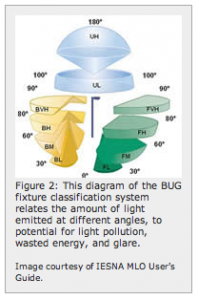Better outdoor lighting
e-News #88: Outdoor Lighting, More Light is Better…Or is It? – the latest newsletter from Energy Design Resources has good information about balancing the need for illumination at night and minimizing light pollution, including tables of recommendations from design guidelines. EDR is California-based, but the data applies no matter where you are.
The federally funded National Optical Astronomy Observatory (NOAO) reports that poorly-aimed, unshielded outdoor lights waste $2 billion (17 billion kilowatt-hours) worth of energy in the U.S. each year. …
While astronomical observatories are located in some of the most remote areas of the earth, light pollution remains an inevitable challenge. Astronomers favor lamp sources that limit their light output to as narrow a portion of the spectrum as possible, leaving the rest for observation. Low pressure sodium lamps fit the bill. These yellowish lights don’t do a great job of rendering colors, which makes them unpopular. LED and metal halide lamps are becoming increasingly popular for outdoor applications, due in part to their energy efficiency and color rendering capabilities, but they are broad spectrum sources of light. These deliver an even greater challenge for astronomers; because they emit light across the spectrum, they interfere at more wavelengths. The white light they emit is a shorter wavelength and more easily scattered in the atmosphere, which increases sky glow and reduces night sky visibility.

